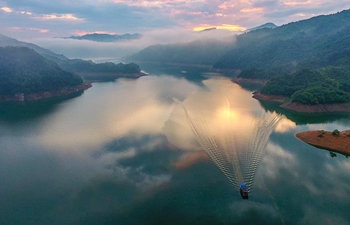SAN FRANCISCO, July 5 (Xinhua) -- Researchers who have spent four consecutive summer seasons in the Antarctic mapping the patterns in distribution and biomass of Antarctic krill have reported that the combined mass of these tiny aquatic organisms is more than that of the world's 7.5 billion human inhabitants.
Detailed in a study published in the journal Deep Sea Research, Kim Bernard, a biological oceanographer at Oregon State University (OSU) and a team of colleagues sought to identify the environmental conditions responsible for krill "hotspots" in the Southern Ocean, also known as the Antarctic Ocean or the Austral Ocean.
Researchers have long known about this zooplankton species, but haven't been certain why particular regions or hotspots in the Southern Ocean are so productive. One such hotspot exists off Anvers Island, along the western Antarctic Peninsula, where high densities of Antarctic krill episodically concentrate near the shore close to a number of Adelie penguin breeding colonies.
It turns out that a perfect combination of tides and wind is responsible.
"This region off the western Antarctic Peninsula has been a known breeding area for Adelie penguins for thousands of years. We know it today as a krill hotspot and it probably has been for some time," said Bernard, lead author on the study. "But despite their abundance, there is growing concern about krill not only because of climate change, but because they are now being harvested for human food, nutritional supplements and aquaculture feed. Yet historically we've known little about what makes this particular area so productive for krill. So we set out to learn more about it."
What they discovered is a near-perfect system in which krill aggregations situated over the Palm Deep Canyon, a region of nutrient-rich waters that produce a lot of food for the krill, are delivered close to shore by tidal currents and winds. When the winds are westerly and the tides are diurnal, namely one high tide and one low tide each day, the krill biomass close to shore is at its peak and krill aggregations are huge.
"We can predict exactly when humpback whales will be close to shore off Palmer Station just based on the tides. When there are diurnal tides, you'll see krill from the surface to the ocean floor -- they are everywhere. And when they are, the whales are there, too," Bernard said. "This concentration and transport toward shore are particularly important for the penguins that breed there. The farther they have to go to forage, the less their chicks have to eat and chick weight is a huge factor in their survival."
And when the tides shift to semi-diurnal, or two high and two low tides daily, currents move the krill away from shore and their predators follow. Likewise, a shift to southerly winds keeps the krill farther from shore and more spread out.
Antarctic krill can live five to seven years, and grow to a length of a little more than two inches, or more than 5 centimeters. They don't reach sexual maturity for two years, and when they reproduce, they must release their eggs in water roughly 1,000 meters, or about 3,200 feet, deep. That's because they need a certain period of time to develop as they drift to the ocean floor, and another period of time to go through different life stages as they re-ascend to the surface.
Studies have shown that sea ice may be critical to their survival, but researchers are not exactly sure why, Bernard said. "We see very strong correlations between krill biomass and sea ice," she was quoted as saying in a news release from OSU on Wednesday.
"When the sea ice is low, the krill populations crash the next summer. It could be a change in algae or other food for them, or it could be that sea ice provides shelter from predators, or affects the currents in some way. We just don't yet know," she said.

















